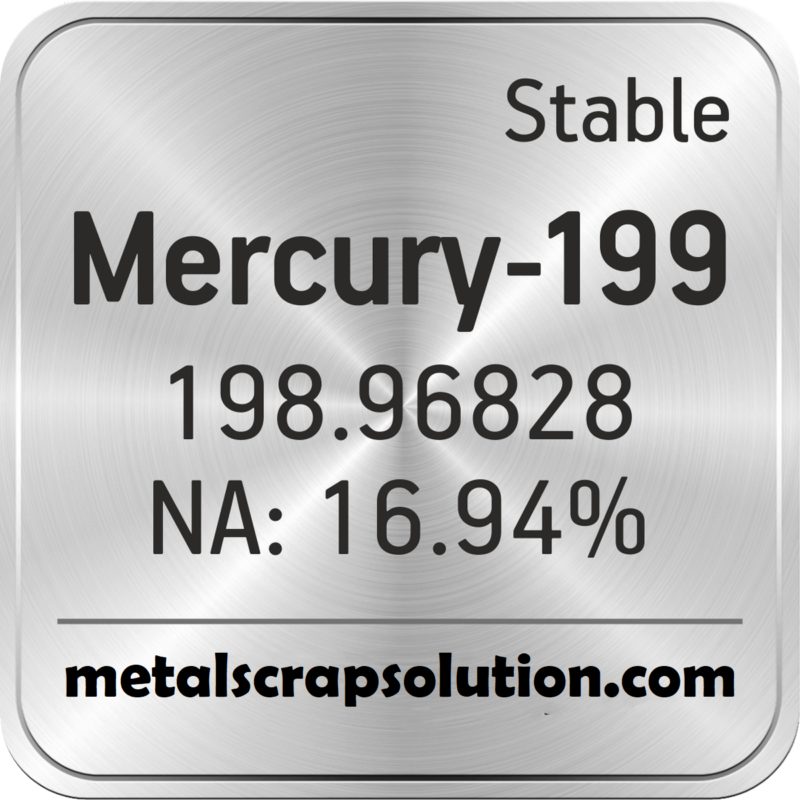水銀 (Hg) 同位体の販売
Mercury (Hg) Isotopes for sale, In ancient cultures, mercury was known and employed. It has been discovered in Egyptian tombs dating back to 1500 BC, in Greek ointments, and in Roman cosmetics. It was named after the planet Mercury, and its symbol, Hg, is derived from the Latin term hydrargyrum, which means “liquid silver.”
Mercury is an incredibly heavy liquid; it is the sole metal and one of only two elements that exist naturally as a liquid at room temperature. It does not wet glass and condenses into small globules. It is insoluble in hydrochloric acid, water, alcohol, and ether; soluble in sulfuric acid when heated; and soluble in nitric acid and lipids. At room temperature, mercury is stable in dry air or oxygen; nevertheless, in the presence of moisture, oxygen progressively destroys the metal, generating red mercury(II) oxide. When heated in air or oxygen (to around 350 oC), the metal progressively converts to its oxide. At room temperature, mercury easily reacts with halogens to generate mercury(II) halides.
Its metal can be converted into both mercury(I) and mercury(II) salts. Dilute sulfuric acid, like air-free hydrochloric acid, has no effect on the metal. Water and molecular hydrogen have no impact on mercury. When exposed to radiation from a mercury arc, atomic hydrogen rapidly mixes with mercury vapours to create hydride.
Important uses of Mercury
The electrical and electrolytic industries use mercury extensively, including batteries and cells in portable radios, microphones, cameras, hearing aids, watches, smoke alarms, wiring and switching devices, mercury vapour lamps, fluorescent tubes, electrical discharge tubes, and mercury electrodes in electrolytic cells. In the electrolysis of sodium chloride to produce caustic soda and chlorine, mercury cathodes are used.
Another significant application is in thermometers, manometers, barometers, and other pressure-sensing devices. Mercury is also utilised as a catalyst in the production of urethane foams and vinyl chloride monomers; elemental mercury and its derivatives have long been used as fungicides in paints and agriculture; and its derivatives are used in medications, pigments, and analytical reagents.
Elemental mercury
Elemental mercury and all of its constituents are extremely hazardous through all routes of exposure. At room temperature, the element has a high vapour pressure, posing a serious breathing hazard. Short-term mercury vapour exposure causes bronchitis, coughing, chest pain, respiratory distress, salivation, diarrhoea, tremors, sleeplessness, and depression. Mercury can harm the kidneys, liver, lungs, and brain.
Organomercury chemicals and inorganic salt solutions can enter the body by skin contact and cause severe poisoning. It builds up as Hg2+ in the brain and kidneys. Mercury has been designated as a priority pollutant metal by the United States Environmental Protection Agency.
Properties of Mercury
| 名前 | 水星 |
| Symbol | 水銀 |
| Atomic number | 80 |
| Atomic weight | 200.59 |
| Standard state | Liquid at 298 ºK (the heaviest known element liquid) |
| CAS Registry ID | 7439-97-6 |
| Group in periodic table | 12 |
| Group name | None |
| Period in periodic table | 6 |
| Block in periodic table | d-block |
| 色 | Silvery white |
| Classification | Metallic |
| 融点 | -38.842 °C |
| Boiling point | 356.58 °C |
| Thermal conductivity | 8.3 W/(m·K) at 298.2 °K |
| Electrical resistivity | 98.4 µΩ·cm at 50 °C |
| Electronegativity | 1.9 |
| Specific heat | 0.14 kJ/kg K |
| Heat of vaporization | 59.0 kJ·mol-1 at 356.58 °C |
| Heat of fusion | 11.3 kJ/kg |
| Density of liquid | 13.53 g/cm3 |
| Electron configuration | [Xe]4f145d106s2 |
| Atomic radius | 1.51 Å |
| Ionic radius | 水銀2+: 1.16 Å (coordination number 6) |
| Ionization potential | 10.437 eV (1st) and 18.756 eV (2nd) |
| Oxidation states | +1, +2 |
| Critical temperature | 1477 ºC |
| Critical pressure | 732 atm |
| Critical volume | 43 cm3/mol |

